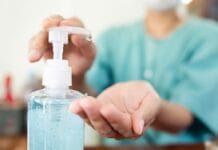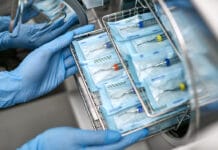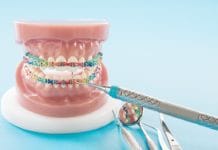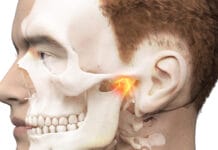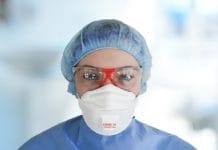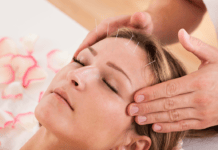Dental professionals must be aware of the potential risks involved within the dental clinic, educate themselves to prevent contamination, and protect all persons within their environment. The production of aerosols and splatter in dentistry is one of the biggest concerns about the spread of infection among both dental professionals and their patients.
With over 700 species of bacteria,1 the mouth can harbor infectious strains that, when aerosolized, can linger for up to 30 minutes in the air.2 When inhaled, dental aerosols can cause respiratory health effects or transmit bidirectional diseases.
The use of high-speed equipment such as scalers and drills in the presence of bodily fluids such as saliva, blood, and plaque has been shown to create dental aerosols that contain microorganisms and blood.3 This is a major concern for infection control within dental surgery. With many dental professionals not protecting themselves or their patients with correct fitting, appropriate level masks, high volume suction, or the use of products that protect the patient’s nasal passages, it’s time to reevaluate the conversation around aerosol management in the dental office and begin taking serious measures to control the risk for both dental professionals and patients.
Common Oral Bacteria and Related Infections
The oral cavity is a diverse, intricate ecological system and consists of many different microorganisms.4 These include viruses, fungi, and bacteria. The species living in our oral cavity are primarily inclusive of six varied groups of bacteria: Firmicutes, Bacteroidetes, Proteobacteria, Actinobacteria, Spirochaetes, and Fusobacteria. The most common strains of bacteria found in the oral cavity are Streptococcus mutans, Porphyromonas gingivalis, Staphylococcus, and Lactobacillus.
Periodontal pathogens and oral bacteria have been linked to contributing to illnesses beyond dental caries, including respiratory diseases.5 Although a direct link has not been confirmed, studies have also shown aerosols to harbor risks to the following illnesses for dental professionals and patients: the common cold, sinusitis, pharyngitis, pneumonia, tuberculosis, SARS, influenza, and swine flu.3
Influenza and coronaviruses are of particular concern in the dental community. These viruses are spread through aerosols, droplets, or direct contact with the respiratory fluids of an infected person. The particles produced by the virus can withstand survival in the air for hours.6 When viruses such as influenza circulate in the air, the potential for transmission increases considerably for vulnerable environments such as dental practices.
Recently, a high number of emerging infections have shown to be those of the respiratory tract that is spread via droplets and aerosols. The ease of transmission allows these viruses the opportunity to spread rapidly, again making dental practices a high-risk environment.
Another highly contagious aerosol transmissible virus that dental practices must exercise extreme caution with is the measles. The measles virus lives in the mucus of infected people in their nose and throat. It is spread by coughing and sneezing and can survive for up to two hours in an environment where the infected person was.
Measles can infect up to 90% of people in close proximity to an infected person.7 Merely breathing in the contaminated air or touching a surface that the harmful particulate matter settles on is enough to transmit the virus. Dental practices must be aware of breakouts within their local community, and ensure thorough screening of patients when an outbreak occurs.
Dentistry Produced Aerosols
The oral cavity is a substantially contaminated environment to work in. Standard dental procedures like ultrasonic scaling, tooth preparation, or operating an air-water syringe, all produce aerosols and splatters. Respiratory infections among dentists have become more frequent, with symptoms related to the extremely contaminated air that is present within the environment. Aerosols remain in the atmosphere for long periods after the patient has completed their procedure, increasing the risk of harmful pathogens for dentists and their assistants.
An aerosol is defined as a suspension of solid or liquid particles in a gas, containing bacteria or viruses. The particle size of an aerosol is less than 50m, and airborne particles larger than this are considered spatter. Bacteria, blood elements, viruses, and particles of tooth, saliva, debris, and tissue can all make up solid and liquid aerosols. The severity of aerosol contamination can be affected by the health of a patient’s saliva, blood, plaque, nose and throat mucus, and the presence of any infection. Aerosol contamination can also occur when the quality of dental unit waterlines are compromised by factors such as water stagnation, heating of the dental chair unit, and contamination of reservoir bottles.2
Dental aerosols can vary in constitution, depending on the health status of the patient and type of procedure being performed. Possible harmful pathogens are most often found in the oropharynx, with the oral biofilm posing as a store for pathogens.2 All patients should be treated as infectious, and the same protective measures taken across the board.
Studies have shown that ultrasonic scalers produce the most intense aerosol and splatter emissions in the dental operatory. The same study reported masks worn by dentists and assistants to have the highest level of contamination. The most common course of contamination was via the respiration of infectious particles that were inhaled after settling on surfaces. Microorganisms present from the contaminated surfaces included Staphylococcus and streptococcus genus and gram-negative bacteria. NonDiptherial, corynebacterium, Staphylococcus aureus, fungi, and Pseudomonas spp were among those microorganisms found in the dental clinic.3
Existing protective measures such as face masks also pose a risk for both dental professionals and their patients. A 2016 study was conducted to analyze the microbiology of dental professionals’ face masks.8 Swabs taken from the face masks of general dental practitioners presented primary contamination of gram-negative Pseudomonas and gram-positive Streptococci species. A high concentration of potentially pathogenic strains such as Staphylococci species was also found. Given that these masks are often in close proximity to the patient’s face, further measures should be taken to minimize cross-contamination and ensure the masks are worn only for one patient and then discarded.
Aerosol Management in Dentistry
The prevalence of harmful dental aerosols calls for appropriate infection control and preventive measurements in the practice to ensure the safety of both dental professionals and their patients. As soon as a patient steps into the dental clinic, the dentist and their team should make every attempt possible to ensure infection control and avoid cross-contamination of bacteria and viruses.
Gaining a clear health history for each patient, completing a thorough examination, and requiring patients to rinse with a microbial mouth rinse before treatments are all necessary best practices. When having the patient rinse prior to treatment, it is important to follow the recommended time according to the rinse. If the instructions recommend a 30-second rinse and the patient just swishes and spits within 10 seconds, for example, the benefits for the rinse are mitigated.
Protective equipment (including gloves), dental face masks that are ASTM level 3 if procedures produce aerosols, and protective eyewear should be worn at all times during procedures. Masks should cover the mouth and nose snugly, be single-use, and changed between each patient. Microbial accumulation in the waterline should be avoided by flushing it at the beginning of every day for at least 30 seconds and in between every patient. The correct positioning of a high volume suction evacuator beside the mouth and handpiece should be utilized and can minimize the production of aerosols by 90%.9
In regard to the decontamination of air in the clinic, HEPA (high-efficiency particulate air) filters, ozonization, ionization, and air sterilization are four technologies targeting air quality. Some, though, are not reliable in getting completely rid of the pathogens.9 HEPA filters send air through various prefilters to assist with catching airborne particulate matter.
In regards to sterilization within the clinic, autoclaving dental handpieces sterilizes the external surfaces, and chemiclave achieves internal sterility. Handpieces should be sterilized after every patient, according to the CDC. Ammonia or enzymatic detergent with water should be used to clean suction lines at the end of every day. Using thin plastic bags to place on surfaces such as controls, handles, armrests, and handpieces within the clinic can help reduce surface contamination.
When practiced correctly, these measures can reduce the cross-contamination of infectious pathogens between people and the production of harmful dental aerosols in the clinic. However, there are further practical actions that should be taken to protect the airways of both dental professionals and their patients.
Additional Items for Patient Protection
Nose filters are a discreet, effective option to protect against airborne particulate matter created during dental procedures. The O2 Nose Filter uses electrostatic technology from 3M to capture allergens, viruses, and other particulates, making them a valuable addition to any dental clinics’ current preventative practices.
There are also masks that only cover the patient’s nose and has a protective shield for the patient’s eyes. These are important devices that can help protect the patient’s upper respiratory tract during dental procedures. Ensuring the patient always has protective eyewear is beneficial to protect them when aerosols are being produced.
With over 700 species of bacteria,1 the mouth can harbor infectious strains, that when aerosolized can linger for up to 30 minutes in the air.2 This means, when a patient is dismissed, the next patient could be walking into aerosols produced by the previous patient. It is so important to take every precaution possible to protect the patient and the clinician during dental appointments.
Aerosol particle contamination in the dental practice is a significant threat to both dental professionals and patients. The level of contamination depends upon the performed dental procedures and the health status of the patient. Best practices to ensure all parties are safe should be mandatory, and professionals should abide by the current CDC (Centers for Disease Control and Prevention) guidelines and standards. Combining protective equipment with air filtration systems, as well as regular flushing of water lines, high volume suction, thorough patient screening, and nose filters are effective approaches to maintain the safety of all parties.
Now Listen to the Today’s RDH Dental Hygiene Podcast Below:
References
- Aas, J.A., Paster, B.J., Stokes, L.N., Olsen, I., Dewhirst, F.E. Defining the normal bacteria flora of the oral cavity. J Clin Microbiol. 2005 Nov; 43(11): 5721–5732. doi: 10.1128/JCM.43.11.5721-5732.2005. https://www.ncbi.nlm.nih.gov/pmc/articles/PMC1287824/
- Veena, H.R., Mahantesha, S., Joseph, P.A., Patil, S.R., Patil, S.H. Dissemination of aerosol and splatter during ultrasonic scaling: A pilot study. J Infect Public Health. 2015 May-Jun; 8(3):260-5. doi: 10.1016/j.jiph.2014.11.004.
- Raghunath, N., Meenakshi, S., Sreeshyla, H.S., Priyanka, N. Aerosols in Dental Practice: A Neglected Infectious Vector. 2016. DOI:10.9734/bmrj/2016/24101.
- Mouth Flora. Retrieved from https://www.sciencedirect.com/topics/immunology-and-microbiology/mouth-flora
- Gomes-Filho, I.S., Passos, J.S., Seixas da Cruz, S. Respiratory disease and the role of oral bacteria. Journal of oral microbiology. 2010; 2. 10.3402/jom.v2i0.5811. doi:10.3402/jom.v2i0.5811. Retrieved from https://www.ncbi.nlm.nih.gov/pmc/articles/PMC3084574/
- Monaghan, N.P. Emerging infections: implications for dental care. Br Dent J. 2016 Jul 8; 221(1):13-5. doi: 10.1038/sj.bdj.2016.486.
- Measles information for dental settings. Retrieved from https://www.cdc.gov/oralhealth/infectioncontrol/faqs/measles.html
- Mareeswari, G., Joy, E., Kiran, M., David, C., Sherubin, E., Manchil, R. Prevalence of microbial colonization in the mouth mask used by the dental professionals. Journal of Medicine, Radiology, Pathology and Surgery. 2016; 2: 7-10. 10.15713/ins.jmrps.49.
- James, R., Mani, A.K. Dental Aerosols: A Silent Hazard in Dentistry! 2016. Retrieved from https://scadental.com/wp-content/uploads/2018/02/7-Dental-Aerosols-A-Silent-Hazard-in-Dentistry.pdf


